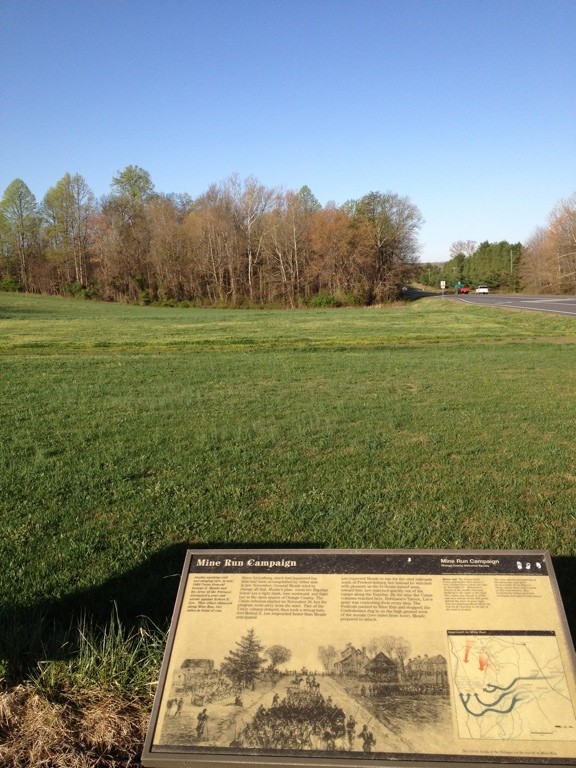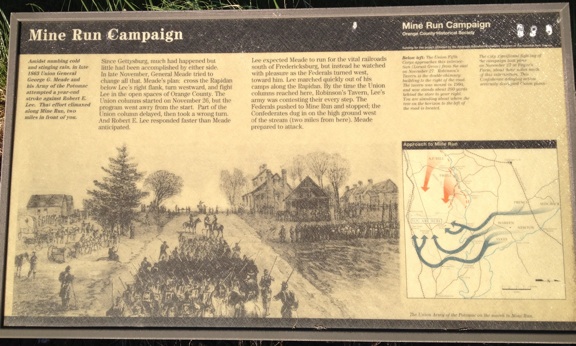Morning at Mine Run
 The first draft of the manuscript is in the mail–always a welcome feeling–but already I’m looking down the road to the next project. In this case, the road I’m looking down is Virginia Route 20. I’m standing at the intersection near the old Robertson’s Tavern in Locust Grove, looking down the long descent in the direction of Mine Run.
The first draft of the manuscript is in the mail–always a welcome feeling–but already I’m looking down the road to the next project. In this case, the road I’m looking down is Virginia Route 20. I’m standing at the intersection near the old Robertson’s Tavern in Locust Grove, looking down the long descent in the direction of Mine Run.
That’s where the next campaign will take me.
Kris White and I have just wrapped up the first draft of our manuscript on the Battles of Second Fredericksburg and Salem Church, Chancellorsville’s Forgotten Front. We already have some revisions to do, and our publisher, the highly supportive Ted Savas, has given us room to expand the manuscript if we’d like. He wants this to be the book on the subject, which isn’t too hard because not much has been written on the battles.
We’re waiting to hear back from several colleagues who’ve been kind enough to look over the book for us. We’ll use their feedback to help guide our revisions. It’s hearting to know, though, that Ted’s initial reaction was unqualified: “The manuscript looks very strong.”
 When I finish a project, I always like to know what’s coming next. I like to have that next project lined up, and I get restless if I don’t. In this case, though, it’s been hard to look ahead because of the intensity of the work Kris and I have been putting into Forgotten Front. Fortunately, as we began wrapping up work, I had an idea to pitch to Ted, which Ted took instantly: a book on Mine Run.
When I finish a project, I always like to know what’s coming next. I like to have that next project lined up, and I get restless if I don’t. In this case, though, it’s been hard to look ahead because of the intensity of the work Kris and I have been putting into Forgotten Front. Fortunately, as we began wrapping up work, I had an idea to pitch to Ted, which Ted took instantly: a book on Mine Run.
I’ve been wanting to write on Mine Run for years, and I’ve slowly been collecting material, but I’ve not had the occasion to make a go of it for a variety of reasons. It was important, too, to get Second Fred/Salem Church taken care of because Kris has been wanting to write that book for as long as I’ve known him. It’s been his real passion project. He wanted to get that book written, and I wanted him to get that book written. I’m really pleased that we’ve been able to make that happen, and I’m gratified that I got to be part of it. Working with Kris is always a fantastic experience. He’s a helluva historian.
Now, it turns out, we get to turn to my passion project.
Mine Run has fascinated me for a long time because it’s an engagement everyone forgets about. It’s the giant battle that almost happened but didn’t, and as a consequence, most people with a casual interest in the Civil War jump from Gettysburg in July of ’63 all the way to the Wilderness in May of ’64 as if nothing took place in between.
However, the armies were in constant contact during the months after Gettysburg, skirmishing, probing, maneuvering, poking, prodding. “The Stations,” as I like to call them (Bristoe and Rappahannock), both resulted in bruises for both sides. The entire chessmatch culminates in the anticlimax of Mine Run—arguably George Gordon Meade’s finest hour as commander of the Army of the Potomac, although he gets no credit for it.


At Mine Run, Meade called off a major attack because he saw how hopeless it would be against surprisingly tough Confederate fortifications. He did so despite immense political pressure from Washington to initiate a major engagement. Meade put the lives of his own men over the dictates of politicians.
The thanks it earned him was the position of second fiddle to Ulysses S. Grant, whom Lincoln would promote to lieutenant general and bring east to manage the war. Grant would ride shotgun with the Army of the Potomac, all but totally overshadowing Meade.
Mine Run foreshadows the Overland Campaign in other ways, too: a growing emphasis on defensive warfare by the Confederates, a bulky Union army that finds it difficult to maneuver quickly, and troublesome dynamics between Union corps commander Major General Gouverneur K. Warren and his superiors.
I can’t wait to start diving into the story in depth. That I get to do so with Kris as my writing partner only makes the campaign look all the more exciting.
Ted, too, will be helping. It seems that Mine Run is a passion for him, too. The illustrative Eric Wittenberg has graciously agreed to pen an introduction for us, as well.

Not much remains of the Mine Run battlefield today: a few earthworks run through the yards of homes that have been built along the former Confederate line; lunettes lurk along the Orange Plank Road, guarding the westward approaches; an old road trace reaches up from Mine Run itself. The geography is easy enough to read if you know what to look for, but mostly, the battlefield has faded into historical obscurity like the engagement itself.
The one bright spot is Payne’s Farm, where the opening engagement took place on November 27, 1863. Preserved by the Civil War Trust, the property features a one-mile interpretive trail that follows the action as it unfolded through wooded gullies and ravines and over rolling farmland. It’s a great little gem of a battlefield.
I’ll be spending much time here over the next few months, I’m sure, as Kris and Ted and I begin to unfurl this story. First, Kris and I will need to put the finishing touches on Forgotten Front. In the meantime, I’m content to stand on this ground and look down the road and imagine the good things that wait ahead.



While the Civil War Trust has excellent interpretation at Payne’s Farm, the rest of the battlefield remains largely uninterpreted beyond a pair of markers from the Orange County Historical Society.


Looking forward to this one. Also looking forward to Salem Church action with my ‘Jersey Boys’
Joe,
We talk about your boys a great deal. I think you will really like what we came up with. We dug up some outstanding accounts.
Sounds like a great story! Also can not wait for ‘Forgotten Front’ to learn more about the 23rd NJ and what my ansestors went through. Is there a planned release date yet???
We found some great accounts of the Yahoos fighting at the Church. Those guys were in a bad spot, but performed well.
Admire Emerging CW. Suggest you go west on Rt 20 & turn North (within 50 yards) after crossing Mine Run Ck. onto short loop that re-joins Local 602.[I use VA Atlas&Gazetteer]. On left (in woods & along a small creek bank, between development homes & on private land…need permission), you will discover 1 mile+ of CSA earthworks, some 10+ feet high. Very impressive…if you like earthworks! Other small earthworks can also be seen along this loop.
stay the hell out of those woods it’s all private you may get shot
Thanks for the tip, Gene. I had the chance to see some of those works a couple years ago and they are, indeed, pretty impressive. But as you say, they’re on private property, so they’re tough to get to, and I’ve not been able to get back there since. I try to be respectful of private property rights when I wrote about places because I don’t want to inadvertently suggest to readers that they go tromping around where they shouldn’t.
Thanks for the kinds words about the blog, too. We’re grateful for your readership!
Sorry…didn’t realize this might be so ‘public’. Agree with respect for private property. How can I contact you abou visiting the NC Civil War Round Table, founded 1955??
Gene,
Email us at emergingcivilwar@yahoo.com I will be sure that the message gets to the right person.
Best,
Kris
Joe/Brian —
No firm release date yet, although there’s the possibility “Forgotten Front” might be out as early as December. We’ll see. At the very least, it’ll be out in time for the anniversary of the battles, for sure.
Eric Wittenberg is possibly going to write a book also:
http://civilwarcavalry.com/?p=3151
Stephen Keating
Stephen,
Eric has graciously agreed to write the introduction and appendix for the book. We are really looking forward to working with him on this, and another project that is in the works. Eric really knows his stuff and has been a great friend to us and the blog!
Stephen,
When Chris and Kris informed me that they were tackling this, and were well under way with it, I decided that the best course of action is to back out of what I was thinking of doing and to instead do all that I can to insure that their work is the best it can be. That includes writing a foreword and perhaps also an appendix on the transformations the happened to the Army of the Potomac’s Cavalry Corps in the wake of Mine Run.
This project is in excellent hands with Chris and Kris, and if I didn’t think so, I would not support them as I am.
Eric
Stephen,
After I made that blog post, Chris and Kris informed me of their project. Knowing the quality of their work, I elected to abandon my contemplated project with this intent of supporting them. I will be doing a foreword for them, and also an appendix on the changes that came to the AoP Cavalry Corps in the wake of the Mine Run campaign.
I have absolute faith and confidence in Chris and Kris, or I would not have decided to back off my project and support them as I am.
Eric
Hi Chris. Great photos. I look forward to your work on the topic of Mine Run. However, I disagree with the assessment that Mine Run was George Meade’s finest hour. If it were up to Meade, the attack would have happened and there would have been thousands of Federal soldiers needlessly killed in front of those formidable Confederate earthworks. Instead, I would posit that Mine Run was one of G.K. Warren’s finest hours (after Gettysburg and Bristoe Station, of course) by suggesting to Meade to cancel the attack that Warren knew would fail. If I recall, Meade was somewhat irritated by Warren’s recommendation. And Warren’s relunctance at Mine Run would form a somewhat false reputation for him as an overly cautious commander and contribute to his ultimate demise at the hands of Phil Sheridan a week before the end of the war.
Meade was, indeed, perturbed by Warren’s recommendation to call off the attack and went to the scene to see for himself. Once he saw for himself what was up, he agreed with Warren’s assessment. So absolutely, Todd, Warren deserves a tremendous amount of credit for making the call he did. I give Meade so much credit, though, because as army commander, the buck stops there–and knowing the pressures he was under from Washington, I think it took tremendous guts to call off that attack. Kris and look forward to exploring all this in much greater detail once we dive into the book.
Oh, and thanks for the kind words about the pics, Todd!
I agree with Todd, but I would also add that Warren had initially promoted the attack in his front so Meade had essentially taken his word and gave him the responsibility of making a successful attack. Warren’s decision to not attack without first informing Meade of changes in situation had to make Meade irritated (Warren had to know Meade was under great political pressure).
But more disturbing about Warren and Mine Run was that this incident seemed to make Warren feel his judgment was better than his commanding General’s and he began to question orders frequently. By the time of Five Forks Warren’s support by high command was tenuous, which then allowed for Sheridan (who had a run-in with Sheridan at Todd’s Tavern in May 1864) to act on his removal with little question from Meade or Grant.
Warren’s star was definitely on the rise by the winter of ’63-’64, and his name had even been bandied about as a possible replacement for Meade (ironic since it was Meade’s stalwart support up to that point that had gotten Warren where he was). Warren would do little in the Overland Campaign to endear himself to either Meade or Grant, though, and his high opinion of himself coupled with his tendency to move overcautiously would lead to his undoing. I’m not a big fan of Warren, though I do think he definitely made the right call at Mine Run.
Greatly looking forward to your work on the Mine Run campaign, and I benefited immensely from your wonderful book on 2nd Fredericksburg and Salem Church. Visited there last year as I researched the movements of the 65th NY, my great-great grandfather’s regiment, as I work on a regimental history. Followed on foot their long march to Gettysburg from Manchester, MD this summer as I wrote about their role in the Gettysburg campaign. Rappahannock Station, Mine Run, and a stint as prison guards at Johnson’s island, Ohio, encompasses my next planned chapter, so your Mine Run book will be eagerly awaited!
Chris Barry
Social Studies Department Chair
Irvington High School
Irvington, NY
I also like how you describe the decision to NOT attack at Mine Run as Meade’s finest hour. I have always felt he did a fine job at Gettysburg and is underrated. Perhaps too cautious in pursuit of Lee after Gburg, but still solid and deserving a bigger reputation than he has.
Of all the information I have researched, nowhere can I find any information on the history of the Madison Payne farm. My grandmother was a Payne from Virginia! Maybe you can shed some light!